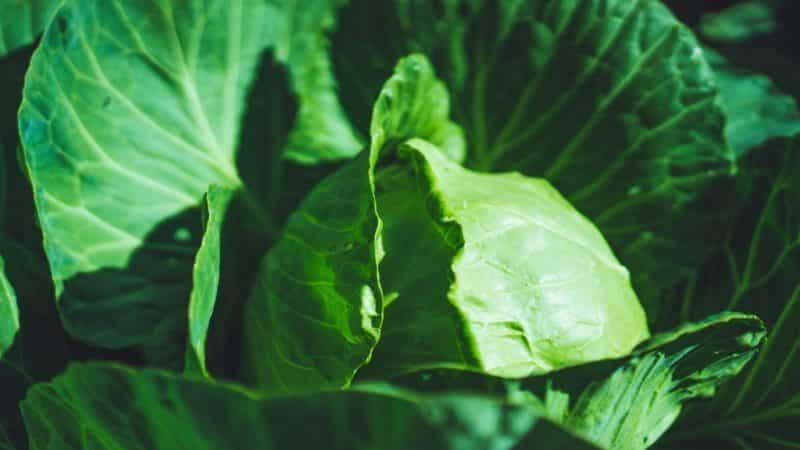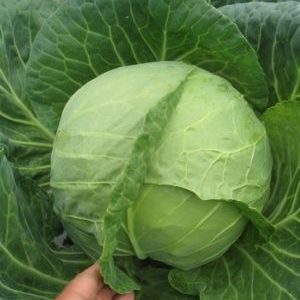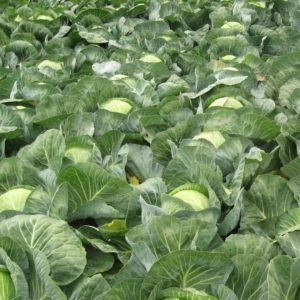Early maturing cabbage hybrid Parel f1
White cabbage is one of the favorite vegetable crops. Most summer cottages cannot do without growing it. Cabbage hybrids are attracting even more attention due to their enhanced agronomic and taste properties. Parel F1, introduced in the early 1990s of the 20th century, is no exception. Let's consider its characteristic features and features.
Description of cabbage hybrid Parel F1
Parel F1 is an early ripening hybrid of white cabbage.
Origin and development
Hybrid Parel F1 was bred by breeders of the Dutch company Bejo Zaden B.V. by crossing several productive varieties. The result was an early ripening vegetable with excellent taste and external characteristics.
It was added to the State Register in 1993 with permission for cultivation on the territory of the Russian Federation. It has gained great popularity and has established itself as a high-yielding hybrid for cultivation in private garden farms and for use on an industrial scale.
Chemical composition, trace elements and vitamins, beneficial properties
The leaves of this cabbage contain a large amount of vitamins and minerals (per 100 g of product):
- C – 50-60 mg;

- PP – 0.55 mg;
- B1 – 0.05 mg;
- N – 0.07 mg;
- B6 – 0.08 mg;
- potassium – 180 mg;
- calcium – 47 mg;
- phosphorus – 25 mg;
- magnesium – 16 mg;
- sodium – 15 mg;
- iron – 1.5 mg;
- mono- and disaccharides – 4.2 g;
- fiber – 0.4 g;
- amino acids – 0.06 g;
- carotenoids – 0.02 g.
Thanks to its rich composition, Parel F1 cabbage has a number of beneficial properties:
- stimulates the functioning of the kidneys and adrenal glands;
- normalizes metabolism in the body;
- helps remove toxins;
- reduces the level of bad cholesterol in the blood;
- promotes weight loss.
Features of application
Parel F1 cabbage has a fresh, sweetish taste and a light cabbage aroma. Best suited for preparing green vegetable salads and stews. It is often used in children's and dietary nutrition. When cooked, the leaves quickly reach readiness and are easily crushed into puree. This variety of cabbage is not intended for pickling, pickling and long-term storage.
Ripening period
The period of full ripening of cabbage heads is 55-60 days from the moment the seedlings are planted in the ground until harvesting. In such a short period of time, strong medium-sized forks have time to form.
Productivity
Cabbage hybrid Parel F1 is considered a high-yielding plant. Depending on the growing conditions, the yield is 4-6 kg per 1 m² with an average weight of one head of cabbage of about 0.8-2 kg.
Important! The quantity and quality of the harvest is not affected by the degree of planting density.
Disease resistance
Hybrids have good immunity to various diseases (root rot, various types of bacteriosis) and pests (flea fleas, butterfly caterpillars, aphids). But at different stages of growth and development, vegetable crops are more vulnerable to them.
Cold resistance
Parel F1 cabbage is resistant to adverse weather conditions and has a stable yield. Spring frosts do not harm young plants - they can withstand temperatures of +2...+5°C.Only during prolonged cold spells do they require protection with covering material in open ground conditions. The most suitable temperature for hybrid growth is +12…+18°C.
Characteristics, description of the appearance of leaves and heads of cabbage, taste

Parel F1 produces round compact heads with a dense internal structure. Their weight varies from 800 g to 1.5 kg. The leaves have loosely closed edges and a soft green color, which changes to milky white when cut. They are located horizontally and vertically. The surface of the leaves is covered with a thin layer of waxy coating, which quickly melts when touched. The heads of cabbage are dense, with a short stalk, which significantly reduces the amount of waste during cooking of the vegetable. Tender, juicy and crispy leaves have a fresh, sweet taste and light aroma.
Growing regions and climate requirements
This vegetable crop is recommended for cultivation in the Central, Volga-Vyatka, Central Black Earth, North Caucasus regions, Eastern and Western Siberia, the Urals and the Far East.
Advantages and disadvantages of cabbage hybrid Parel F1
The main advantages of Parel F1 include:
- rapid period of harvest ripening;

- attractive external characteristics;
- preservation of presentation during transportation;
- high productivity;
- simultaneous ripening of heads of cabbage;
- smooth fruits with good density and a small stalk;
- high immunity to diseases and pests;
- good seed germination;
- resistance to adverse weather and short-term frosts;
- no cracking if care instructions are followed.
Among the disadvantages it is worth noting:
- unsuitable for pickling, pickling and canning;
- small size of heads of cabbage compared to other varieties;
- short-lived shelf life;
- the need to purchase seeds every season.
Features of planting and growing
Growing white cabbage Parel F1 is possible in open or closed ground. To get a good harvest, it is recommended to adhere to the basic rules and features of cultivating this hybrid. In this case, you can use both seedling and non-seedling methods.
Preparing for landing
The seedling method of cultivation involves the preparation of seed material and seedlings.
Seed preparation
At the end of March, cabbage seeds are pre-disinfected by soaking in a weak solution of potassium permanganate, and sown in prepared containers with disinfected and moistened soil, and then placed in greenhouses or greenhouses. Until germination, they are watered with settled water in moderate mode.
Important! Parel F1 cabbage seeds are not collected, since they are not capable of reproducing varietal characteristics in hybrids.
Preparing seedlings
At this stage, preparatory procedures are carried out:
- Cover the seedling box with film or glass until the first shoots appear.
- Picking young plants as they grow, the first of which is carried out already on the 10-15th day.
- Regular watering no more than 1-2 times a week with settled water.
- Fertilizing with nitrogen-containing fertilizers (or wood ash) - 1-2 times during the growing season.
- Hardening off seedlings by ventilating the greenhouse during the day.
- Ensuring sufficient lighting levels.
- Application of potassium-phosphorus fertilizers to activate the growth of the root system several days before planting seedlings in the ground.
When cultivated through seedlings, cabbage is ready for planting in open ground after 3-4 weeks when 3-5 full leaves are formed. This usually happens in early May. In regions with cold climates, these dates are shifted by 7-14 days.
How to plant without seedlings
The seedless method of growing hybrid cabbage is characterized by a later harvest, but the plants are less sick without replanting and have more developed roots. The place for sowing the crop is selected and prepared in the fall. A sunny area is best suited, where the soil is dug up, fertilizers are applied and beds are formed. They are insulated on top with a layer of mulch and dark agrofilm. With the arrival of spring warmth, the covering is removed and the seeds are sown according to the pattern of 4-5 bushes per 1 m² of soil. Grown plants are regularly fed with nitrogen, potassium and phosphorus fertilizers.
Reference. Vegetable gardeners determine the timing of sowing seeds in open ground independently, taking into account the climate of the area. Necessary condition: the air temperature should not fall below +8°C.
Soil requirements
Loamy, fertile soils are considered the best soil mixture for cabbage. Optimal acidity is pH 6.5-7.5. For seedlings, the soil mixture is purchased in stores or prepared independently from equal parts of turf, compost, humus and sand. Add ash (200 g per bucket) to the substrate, mix thoroughly and pour in plenty of potassium permanganate.
Predecessors
Suitable precursor plants for Parel F1 cabbage are potatoes, pumpkin, perennial herbs, legumes. It is not recommended to choose last year's sites and places where tomatoes, beets, turnips and radishes grew.
Dates, scheme and rules of planting
Parel F1 cabbage should be planted at the appropriate time. For the seedling method, this is sowing seeds in March - early April and planting plants in open ground in May. Young bushes are placed at a distance of 50 cm from each other, maintaining a distance between rows of about 30 cm. The time for planting this crop without seedlings is mid-April. Seeds are sown in separate holes - 4-5 pieces per 1 m².
Planting density and depth
For cabbage seeds, the sowing density is about 3 cm from each other at a depth of 1 cm. Seedlings are planted to a depth not exceeding the growth point, adhering to a 50x30 cm pattern.
Features of cultivation
Caring for cabbage seedlings requires timely and careful attention to compliance with all necessary measures. They are common to all varieties of crops. Among the features of the hybrid, one can note the tendency for fruits to overripe.
Despite the fact that hybrid cabbage is an unpretentious plant, the plants should be provided with timely watering, weed removal and soil loosening, fertilizing and treatment against diseases and pests.
Watering mode
Cabbage prefers well-moistened soil, so it should not be allowed to dry out. In regions with long periods of drought, seedlings are watered with settled water at least 2-3 times a week in the evening. In climates with moderate humidity levels, it is enough to water the bushes once a week or as needed.
Loosening and hilling
Frequent loosening of the soil is not required. It must be done no more than once every 14 days, acting carefully so as not to damage the leaf rosette. When the bushes grow and heads of cabbage begin to form, it is better to remove the weeds by hand.Hilling is vital for cabbage, because the stem sprinkled with soil becomes stronger and less susceptible to diseases. The first procedure is performed 3 weeks after planting.
Top dressing
Nitrogen fertilizers are applied sparingly, trying not to interrupt the head setting phase. It is enough to carry out 1-2 such feedings per season.
Important! If the leaves of the plant become dull and lose color, it is recommended to additionally fertilize the plants with nitrogen.
During the formation of the ovary, potassium-phosphorus fertilizers are used. To do this, use a solution of potassium nitrate or wood ash.
Measures to increase yield

To increase cabbage yield use:
- timely removal of weeds;
- additional feeding of plants with nitrogen-phosphorus fertilizers;
- timely release of leaves from insects and traces of their vital activity;
- prevention of fungal and bacterial diseases;
- increasing the frequency of regular watering during the formation of heads of cabbage.
Disease and pest control
Parel F1 cabbage is highly resistant to various diseases and pests. But if left untimely, there is a risk of damage to the plant:
- root rot - softening or rotting of the stem occurs;
- clubroot - growths or swellings appear on the leaf plates;
- downy mildew – spots and heavy coating on the leaves;
- fusarium - characterized by yellowing of foliage and damage to roots;
- vascular bacteriosis - spots appear on the surface of the leaves;
- mucous bacteriosis - brown oily spots and a putrid odor are formed.
To destroy the infection, plantings are treated with fungicidal preparations. If you become infected with root rot, you must temporarily stop watering.If the plant is in a greenhouse, it is necessary to increase ventilation and reduce humidity.
Sometimes the cabbage hybrid is also affected by harmful insects:
- cruciferous flea beetles, leaf beetles and cabbage flies attack plants during the seedling period;
- cabbage white is activated during fruit set;
- aphids attack ripe heads of cabbage.
When the first pests are detected, you can use folk remedies - tobacco or ash solutions. They are also used as prophylaxis. If these methods do not help, you should move on to biological insecticidal preparations. In particularly difficult cases, strong chemicals are used.
Attention! Chemical insecticides are allowed to be used at least 1.5 months before harvesting.
Difficulties in growing
Growing a hybrid does not present any particular difficulties. The culture is easy to sow and care for. Compliance with watering and fertilizing regimes will allow you to get juicy, tasty heads of cabbage.
Harvest and storage

Heads of Parel F1 cabbage reach full maturity in the first half or mid-July. You must not allow them to become overripe, otherwise they will begin to crack.
How and when to collect
In July, ripe cabbage heads are harvested by carefully cutting off the stalk with a sharp tool at the very base. You can still keep them in the garden for 1-2 weeks, making sure that they do not lose their external qualities - the plugs should be shiny and dense.
Reference. Depending on the time and method of planting cabbage, it is possible to harvest until autumn.
Storage features and shelf life of the Parel F1 hybrid
The hybrid is not intended for long-term storage and has low shelf life. After cutting, the vegetables are ventilated on an open floor and put away in the intended place.Cabbage is consumed within 3-5 weeks after harvesting.
Reviews from summer residents
Reviews about Parel F1 cabbage are contradictory. Experienced gardeners note high taste, immunity, productivity, but a tendency to cracking and a short shelf life.
Lyubov, Izhevsk: “Several years ago I read reviews and purchased Parel F1 seeds in the original Dutch-made packaging; since then, of all the early varieties of cabbage, I recognize only this one. I sow the seeds for the first time in the greenhouse directly into the ground. The seedlings grow strong, and the harvest is early - in the second half of June. The second time I sow the seeds in open ground in May - this keeps the cabbage happy until the fall. Heads of cabbage up to 2.5 kg grow on the site. They are all smooth, dense, and the stalk is very small. The only negative is that it often cracks during aging. It doesn't last long - no more than 2 months. Incredibly delicious fresh."
Nikolay, Moscow: “I have long dreamed of having a summer cottage. And recently I acquired a small garden area. He immediately built a greenhouse. I saw Parel F1 cabbage seeds in the store and decided to try to grow them. The harvest exceeded all expectations - the cabbage is juicy, sweet, tasty and healthy. I didn’t treat the plants with anything and didn’t observe any diseases.”
This is interesting:
How to properly ferment cabbage heads.
What are the benefits of sauerkraut juice for the face and how to prepare various masks with it.
Conclusion
Hybrid Parel F1 is an early-ripening and unpretentious cabbage. It is distinguished by its rapid ripening, good seed germination, the adaptability of young seedlings to unfavorable conditions and the remarkable taste of ripened heads of cabbage. Growing does not require special knowledge and skills.You just need to follow the general rules for preparing for planting and caring for plants, and then a tasty and healthy harvest will delight summer residents and agronomists.